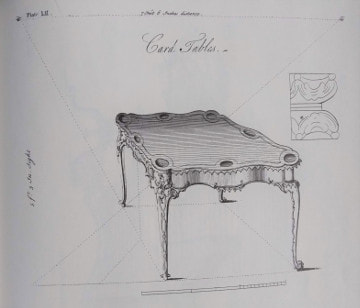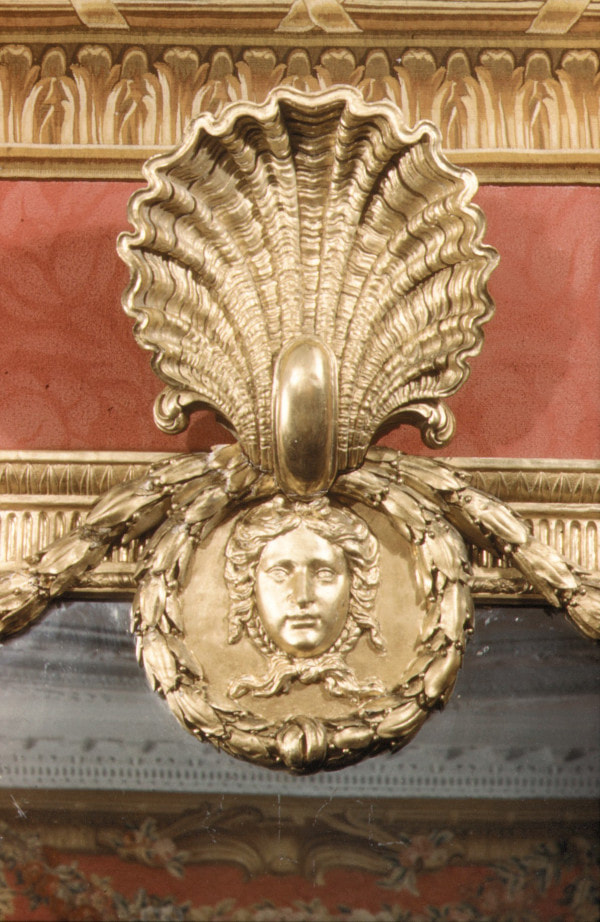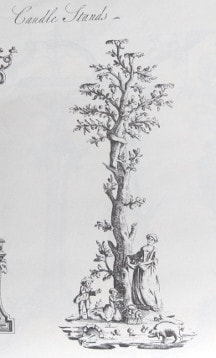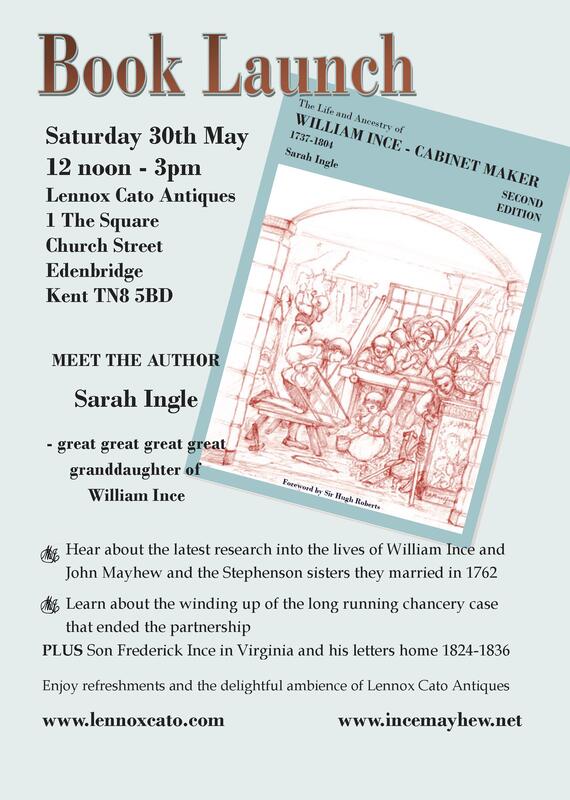|
Cousin Matt Coles has alerted me to a tripod table listed in Bonhams Fine Decorative Arts auction to be be held on 23rd June 2021. The table is in the rococo style and has similarities to the drawings by William Ince in the Universal System of Household Furniture plate xiii. Suggested bids are between £12,000 and £18,000.
Back in August 2018 an Ince & Mayhew tripod table was for sale at Nicholas Wells, and in my blog I made reference to the book by Ronald Phillips which has amazing information about tripod tables. I had a fun afternoon last weekend looking at Ince & Mayhew serving tables. Once again, someone had contacted me through this website to ask about my research and see if I had any knowledge of a particular serving table which was decorated with amazing rams' heads.
I discovered that Christie's held a sale last week at which an Ince & Mayhew serving table was sold for £17,500. This magnificent piece has swags and carved husk pendants, a good indication that it was made by the firm. The craftsmanship is superb. The Lot Essay describes a number of tables that have similar features to this one, and are proven to have been made by them. Another beautiful carved mahogany table attributed to the firm was sold in March last year. This had a goat's mask with beribboned husk swags for decoration and went for £20,000. A magnificent I&M tea caddy was sold in the same auction for $4750. It was the property of the Earl and Countess of Perth, sold in 1996. TODAY in Christie's New York Auction, you will find the Parham Park Ince & Mayhew Suite, a suite of George III cream and blue painted mahogany dining room furniture, including a serving table and two urns. There are matching side tables, one of which dates back to 1775 made by Ince & Mayhew, the other more recent. The Suite was supplied to Sir Cecil Bisshopp, 8th Bt (later 12th Baron Zouche) 1753-1828 for Parham Park, Sussex and sold by Christie's in 1966 by the executors of one of his descendants. It is worth looking at the photos in close-up to admire the workmanship. The estimate for the serving table and urns is $80,000 to $120,000 and for the side tables $30,000 to $50,000. Also in this auction a copy of the Universal System of Household Furniture is up for auction in New York, with an estimate of $8000 to $12,000. At the bottom of the frontispiece is a note that the book is 'To be had of the Authors & at A Weoblys near Chancery Lane Holborn & of all other Booksellers.' It will be interesting to see what price they make. It was very interesting to be contacted via the website recently by a Canadian researcher who is a descendant of Thomas Malton, who wrote The Complete Book of Perspective in 1775. The researcher had got in touch as Henry Robert Ince and James Gray Mayhew were mentioned in James Malton's will, this James being the son of Thomas Malton. James Mayhew was an executor of the will and it was proved on the oath of Henry Robert Ince in 1803. According to the will, all three were 'well acquainted' and 'dear friends'.
As the sons of William Ince and John Mayhew were close friends of Thomas Malton's son, it raised the question of whether the older generation were also close. We know that William Ince subscribed to Thomas's book, and it seems likely that they were already acquainted as two drawings by William in the Universal System for Household Furniture, published 1762, actually include the perspective - these are the card tables, items LII and LIII. Thomas Malton was based in Drury Lane as a cabinet-maker, so is likely to have known William Ince who did his apprenticeship round the corner in King Street, Covent Garden, and also lived in the area as a child. Thomas Malton, John Mayhew and William Ince were all Freemasons, though members of different lodges. James Malton was also a Freemason, and John Mayhew Jnr was a member of the same Lodge - Moderns Grand Lodge. Thomas Malton was an architectural draughtsman and teacher of perspective in both London and Dublin. He exhibited architectural drawings at the Royal Academy from a London address in 1772-75 and again in 1785, and then settled permanently in Dublin. A touch of serendipity is that the engraving of St George's Church, Hanover Square in this website is by Thomas Malton's son Thomas, who was an English painter of architectural views, and an engraver. J M W Turner was one of the pupils who attended his evening drawing classes. I was hoping to give you an interesting story about a family who lived in Worcester in the 1700s who had a daughter called Mary, who just might have been the wife of John Ince, William Ince the Cabinet Maker's father. However, although the father's name was Timothy, and the first born sibling of William was called Timothy, with the help of the Archive Team at The Hive, Worcester I have discovered that this Mary was unmarried in 1731, when her mother died and she signed the probate agreement, so she cannot be the right person.
The good news is that thanks to Ancestry uploading some earlier parish registers for Westminster, we know that John Ince married a Mary Edwards on 29th March 1725 in St James Piccadilly, London. The entry for their marriage includes the initials S M L which stand for St Martin Ludgate, the parish in which John Ince was residing as an apprentice to James Welch. Mary Edwards was described as of the same parish. There are many girls called Mary Edwards who were baptised in London around the right time to marry in 1725, but none of their fathers were called Timothy and for the moment, finding any more about her remains an impossible task. Any ideas for where else to look would be welcome. I am very pleased with the review of William Ince Cabinet Maker in the August edition of the Furniture History Society’s Newsletter.
Lisa White calls it a welcome second edition and picks up on the extra chapter about John Mayhew and the lively careers of Ince’s descendants. She says: Sarah Ingle’s book is of interest to the furniture historian as well as the social historian, for she traces the lives of many members of the Ince family from the early sixteenth century in Elmley Lovett, near Kidderminster in Worcestershire to the famous cabinet-maker’s father… Throughout, Ingle paints a convincing picture of the economic and social background for the family making its way from relative provincial obscurity to William Ince’s pre-eminence in Britain’s furniture industry in London’s fashionable West End in the1760s to the 1790s. She also picks up on the contrast of the Ince family’s modesty with the more socially assured, wealthy John Mayhew who financed the furniture business. She mentions a helpful list of the exotic woods they used in their finest pieces and says This volume serves as a reminder to all furniture historians to ‘dig deep’ into parish records, marriage bonds, wills, deeds and indentures. Lily White, Furniture History Society Newsletter, no. 219, August 2020 There is a short section in the second edition of William Ince Cabinet Maker about the abolition of slavery in Jamaica. George Cowell, son-in-law of William Ince, who took on the Chancery Case that ended the partnership of Ince & Mayhew after Ann Ince died, had an interest in the Hopewell estate in Hanover, Jamaica as a trustee for his brother John, who had lent money to the owner, William White. The owner wanted to close the whole business in 1804, before the abolition of the slave trade in 1807. Slavery was not abolished in the British Caribbean until 1834 and the son of John Cowell was awarded over £7000 as compensation.
Charles Vogel Ince, son of Charles Ince married George Cowell's daughter Isabella. A notice about their wedding in 1828 in The Morning Chronicle states that Charles was of Kingston, Jamaica and their daughter Ada was born there in 1830. Charles was probably helping to run the sugar plantation. He died there in 1833. There were still 86 enslaved people on the estate in 1835, but no records to tell us who they were. After abolition the newly freed men and women were bound into a system of apprenticeship so they were still not at liberty. The Centre for the Study of the Legacies of British Slave-ownership at University College London has a wealth of information.
A lovely tea chest is on offer in the Christie's auction Chieveley House, Berkshire and Five Private Collections to be held on 19th March.
It is dated around 1770 and is made of tulipwood and satinwood. The marquetry on the lid is amazing as it looks like a fluted frieze. Inside there are two rosewood lidded wells. The body is inlaid with flowers, foliage and urns and has a coat-of-arms, consisting of a chevron between four double-headed eagles. Its provenance is the Property of the Earl and Countess of Perth; sold Christie’s, London, 18 April 1996, lot 4 and the estimate is £3,000-£5,000. There is also an attractive serpentine shaped serving table. It is made of mahogany and has a fluted frieze with a goat mask at the centre. I wondered about the significance of the goat, as more often it's a ram's head that is depicted - something about sheep and goats comes to mind. It is dated around 1775. The estimate is £8,000 to £12,000. Both these items are attributed to Ince & Mayhew, and there are also two tables in the manner of the firm. Advanced notice that the new edition of William Ince Cabinet Maker is nearing completion. The manuscript is finished and I am just waiting for a few copyright permissions for images. All going well there will be an official book launch in a couple of months and I hope to be able to make some preview copies available at a special discount price for anyone willing to write a review.
This book will be about twice the size of the original with a greater emphasis on celebrating the work of William Ince. It will also include new information on his father and sisters in Worcestershire, his wife’s family in London and his son Frederick’s remarkable adventure in America taken from the letters he wrote to his family back in England between 1824 and 1836. There will be a chapter on John Mayhew and his family, including new research on John’s baptism and his siblings, and information about his children and grandchildren, including royal dentists and the State Trials for High Treason. There will also be information on some of William’s more notable descendants, including the colourful actress Annette Ince, who played Juliet to John Wilkes Booth’s Romeo and the artists Joseph Murray Ince, Charles Percy Ince and Charlotte Grace Cowell. I will keep you posted. |
Author
Sarah Ingle is the great great great great grand-daughter of William Ince and has been researching her family history for a number of years. She thoroughly enjoyed the detective work involved in tracing William’s lineage. Archives
December 2022
Categories |





 RSS Feed
RSS Feed